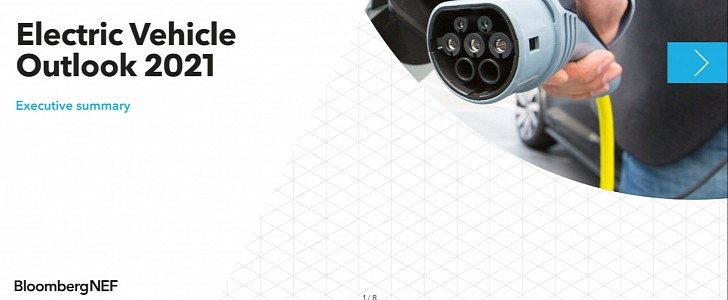The Paris Climate Agreement wants the world to become carbon neutral by 2050. Transportation will play a massive role in getting there, and BloombergNEF is tracking down all the measures being taken for that. With its Electric Vehicle Outlook 2021, the company presents a comprehensive report on what is going well and what still needs to be addressed.
Among other conclusions, the most important one relates to the pace of electric vehicle adoption in emerging and poor countries. EVs are still very expensive for these markets. Even if the last car with a combustion engine were sold in 2035, we would still need to go through a worldwide fleet renovation process by 2040 to retire more pollutant vehicles for good. If you live in an emerging country and sees 50-year old buses and trucks still running, you know what a challenge this is.
Nowadays, there are 12 million electric passenger vehicles in the world, which corresponds to 1% of the global fleet. By 2025, BNEF estimates we will have 54 million, which will leave 1.146 billion to replace if we are talking just about keeping the numbers as they currently are. There’s a massive chance that they will improve.
Think about that: when combustion-engined cars are not wanted anymore in Europe or China, the used ones will not necessarily be scrapped. Instead, they’ll probably be exported to countries in which they still have a good value. With the flood of used vehicles to these markets, used ICE cars will become more affordable. That means people that cannot afford them will finally be able to buy one.
Without a global policy for electric mobility, we will only see carbon dioxide emissions migrate from some countries to others. Considering the issue is with the concentration of greenhouse gases in the atmosphere, not in specific places, forbidding combustion engines in some spots and not in others can become as helpful as beating a dead horse.
To reach net-zero, 60% of all vehicles worldwide should be running on pure electricity or hydrogen. Falling prices for lithium-ion batteries may help, but they depend on new technologies and more raw materials, which can also be an environmental concern.
If you are interested in the future of transportation, check BNEF’s report and read the whole thing. It is optimistic but does not refrain from acknowledging that there is still a lot of work ahead to ensure personal transportation has a (clean) future.
Nowadays, there are 12 million electric passenger vehicles in the world, which corresponds to 1% of the global fleet. By 2025, BNEF estimates we will have 54 million, which will leave 1.146 billion to replace if we are talking just about keeping the numbers as they currently are. There’s a massive chance that they will improve.
Think about that: when combustion-engined cars are not wanted anymore in Europe or China, the used ones will not necessarily be scrapped. Instead, they’ll probably be exported to countries in which they still have a good value. With the flood of used vehicles to these markets, used ICE cars will become more affordable. That means people that cannot afford them will finally be able to buy one.
Without a global policy for electric mobility, we will only see carbon dioxide emissions migrate from some countries to others. Considering the issue is with the concentration of greenhouse gases in the atmosphere, not in specific places, forbidding combustion engines in some spots and not in others can become as helpful as beating a dead horse.
To reach net-zero, 60% of all vehicles worldwide should be running on pure electricity or hydrogen. Falling prices for lithium-ion batteries may help, but they depend on new technologies and more raw materials, which can also be an environmental concern.
If you are interested in the future of transportation, check BNEF’s report and read the whole thing. It is optimistic but does not refrain from acknowledging that there is still a lot of work ahead to ensure personal transportation has a (clean) future.

